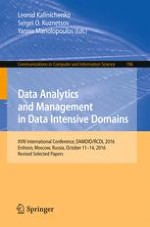2017 | Book
Data Analytics and Management in Data Intensive Domains
XVIII International Conference, DAMDID/RCDL 2016, Ershovo, Moscow, Russia, October 11 -14, 2016, Revised Selected Papers
Editors: Leonid Kalinichenko, Sergei O. Kuznetsov, Yannis Manolopoulos
Publisher: Springer International Publishing
Book Series : Communications in Computer and Information Science
